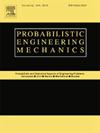空间随机沙中活动浅层活板门的概率稳定性分析
IF 3
3区 工程技术
Q2 ENGINEERING, MECHANICAL
引用次数: 0
摘要
了解土壤摩擦角的空间变异性对活板门稳定性的影响仍然至关重要,特别是在砂质沉积物中常见的浅层活动活板门构型中。本研究采用随机自适应有限元极限分析(RAFELA)与蒙特卡罗模拟(MCs)相结合的方法,对空间随机沙中浅层活动活板门进行了概率稳定性评估。用稳定数表示的数值解,通过确定性分析和概率分析进行了验证。综合参数研究考察了覆盖深度、土壤摩擦角和空间变异性参数(包括变异系数和水平/垂直相关长度)对所选安全系数(FoS)对应的破坏概率(PF)的影响。观察到的破坏机制揭示了独特的可变滑动面,突出了地质力学中随机场问题的本质。该研究最终开发了实用的基于等高线的设计图,用于快速评估嵌入空间随机砂中的活动浅层活板门的PF。这些研究成果为工程师提供了有价值的指导,促进了埋地结构初步设计的明智决策。本文章由计算机程序翻译,如有差异,请以英文原文为准。
Probabilistic stability analyses of active shallow trapdoor in spatially random sand
Understanding the influence of spatial variability in soil friction angle on trapdoor stability remains crucial, particularly in commonly encountered shallow active trapdoor configurations within sandy deposits. This study presents a probabilistic stability assessment of shallow active trapdoors in spatially random sands, employing Random Adaptive Finite Element Limit Analysis (RAFELA) integrated with Monte Carlo simulations (MCs). The numerical solutions, expressed in terms of stability number, are validated through both deterministic and probabilistic analyses. A comprehensive parametric study examines the effects of cover depth, soil friction angle, and spatial variability parameters (including coefficient of variation and horizontal/vertical correlation lengths) on the probability of failure (PF) corresponding to selected factors of safety (FoS). The observed failure mechanisms reveal distinctively variable sliding surfaces, highlighting the nature of random field problems in geomechanics. The study culminates in the development of practical contour-based design charts for a quick assessment of PF in active shallow trapdoors embedded in spatially random sands. These research outcomes offer valuable guidance for engineers, facilitating informed decision-making during preliminary design of buried structures.
求助全文
通过发布文献求助,成功后即可免费获取论文全文。
去求助
来源期刊

Probabilistic Engineering Mechanics
工程技术-工程:机械
CiteScore
3.80
自引率
15.40%
发文量
98
审稿时长
13.5 months
期刊介绍:
This journal provides a forum for scholarly work dealing primarily with probabilistic and statistical approaches to contemporary solid/structural and fluid mechanics problems encountered in diverse technical disciplines such as aerospace, civil, marine, mechanical, and nuclear engineering. The journal aims to maintain a healthy balance between general solution techniques and problem-specific results, encouraging a fruitful exchange of ideas among disparate engineering specialities.
 求助内容:
求助内容: 应助结果提醒方式:
应助结果提醒方式:


